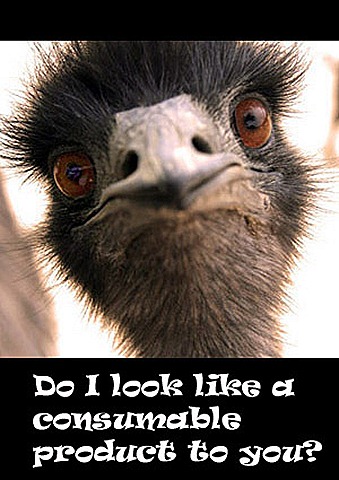Hi All,
You must have heard it. The Emu propaganda in Tamilnadu reached it’s peak in the last 6 months. With cinema actors working overtime to promote emu without any logical reasoning behind their promotions, the bubble was set to burst anytime. And it did burst spectacularly well. I had been reading about emu’s and the project models of similar scams for quite some time now (from the moment I saw some 6 emu’s, roaming in my Uncle’s farm).
Any new product/project operates on the basis of supply and demand. Even when marketing a product that has every chance to fail miserably, the introduction of the product in the public market may create a fallacy that the product is going to be successful. There are some products which are carefully and strategically marketed so that they create a virtual demand. Since this virtual demand cannot resist the abundant supply with the progress of time, the supply catches up with the meagre demand and the structure collapses.
The emu story
When the emu market was flourishing in the early 2000s, the price of emu was very high. Early breeders were very successful and were able to lure more new breeders into the trade based on their own economic growth, because the early breeders had a demand for which they could supply. Once the breeders started to flood in, the number of emu chicks increased. This happened because the first generation emu chicks that were imported, reproduced. New yearlings were sold to farmers and barn owners, who brought in more sophisticated technology to increase the produce.
By the end of 2012, there were almost 300 firms promoting emu business and more than 12000 farmers and barn owners had invested in the business. The amount collected was INR 150,000 for provision of 6 chicks. The chicks were supposed to be bought at the end of 1 year by the firm that supplies the emu’s to the farmers. Despite paying INR 150000 as a deposit, the farmers were forced to pay more money to build sheds to aid in maintaining the birds. The farmers were promised returns of more than 1000 INR per every bird every month. So a farmer investing INR 150000 on 6 emu chicks was assured of a return of INR 7000 every month including maintenance charges. For a more detailed pricing, please click here.
Before we go into the analysis of why our farmers trusted the emu business, we need to look at another aspect.
Why the emu business was doomed to fail?
Firstly, any product has to calculate its supply-demand well. A breeding pair of emu actually produces more than 120 breeding pairs in 5 years. The growth is exponential. So the calculation failed miserably because the demand was met easily. It would not have been an issue if the end market had developed. That was the second reason.
Any business runs on the supply-demand equation. To have a suitable demand, the business needs to have ample number of end users. The entire emu industry was built on speculation because I haven’t personally met anyone who has told me that emu meat tastes great. Despite the scientific evidence of the medicinal properties of emu oil, the industry failed to take off in India, because the promoter’s of the emu market anticipated the Indian population to indulge in emu. Knowing Tamils, no new meat is welcome here. The traditional poultry, fishery, and red meat industry is very strong in Tamilnadu and for a new product to have a bite into that market, it would need much more than medicinal property as a USP.
Since the beginning of the emu sale in India, there was no clear cut market for emu. The situation became worse when the restaurants refused to serve emu meat as an alternative to poultry. This made the promoters of emu to open their own restaurants and continue marketing their products.
The projected rates of the emu products were as below:
-
Emu feathers are used in hats, dresses, computer and car cleaning brushes and household decorative items. About 400 to 600 grams of feathers would be available from a bird and would fetch about INR 200.
-
Emu skin is used in the production of shoes, wallets and other stuff. Cost is around 700-1000 INR per square feet. A matured bird will provide 8-12 square feet of skin.
-
Emu oil is used for its medicinal properties. It sells at around 3000-4000 INR (refined) or 1000 INR (raw fat).
-
Emu meat is consumed and has very low cholesterol levels. One (1) kilogram of emu meat sells around 350-400 INR.
-
Emu eggs – I have no idea about the price.
so when you consider a fully grown bird that would weigh around 40-50 kg, excluding wastage, you should be able to sell around 35 kgs of meat. So in total, a bird should provide you an income of 30000 when it matures.
The problem was – the demand was not so. I haven’t seen anyone even posting a message on emu products. However, the promoter’s were going guns. The poultry stronghold districts of Salem, Erode, Namakkal, and few others were the areas targeted by the promoters. The poultry industry and agriculture industry was already handicapped by existing problems. The farmers were looking out for a source of income and emu looked like a boon to them. They fell into the trap.
Why a consumer base did not develop?
The answer is very simple. To accept emu, it had to be an integral part of their culture. Indian’s prefer the traditional meats. Secondly, there was not so good news for emu meat when more information started reaching people by means of various media. A study by Taylor et al (1996) showed that emu meat was inferior in taste to beef and pork meat. Another study by David Holben (2009) stated that people preferred cow or turkey meat over emu meat.
The biggest blow came when Food and Drug Administration of the USA listed emu oil as a health fraud in its website under the topic “bioterrorism and drug preparedness.” Individuals were not willing to buy emu meat to be cooked at home because they were sceptic. Even the restaurant’s that were set up by the promoters to sell emu meat were only looked on and did not have many visitors. Other restaurants looked up on the emu meat as a non-sellable investment in their menus. For people in India, emu meat was neither healthy for a good price nor exotic to be sold at a higher price. The prices plummeted in 2011. In 2012, the bubble burst when the promoters could not pay their breeders enough money to keep the business going.
What will happen after this?
Emu farms have been sealed, proprietors arrested, and money has been lost. Emu has lost the trust of Indian public after this scam.
To know another thing, this scam is not the first emu scam in the world. There have been reports of earlier ponzi schemes with emu (Ontario in 1996). In fact, the inspiration for this post arose by reading an article by Calum Turvey and David Sparling, 2002. I am heavily influenced by their article. My sincere thanks to them. Some parts of this post may be a copy but my ideas synced with theirs totally and they had explained it in a better way than me.
But then, the marketers and promoters will come up with something new to lure the money out of not-so-wise investors.
What should you do?
Google first. Speak to people. Ask a more important question first – Who is the end-user? Analyse the supply-demand situation. Study about it. Read about it.
Let’s not make Tamilnadu the home of Ponzi schemes. The economic times has quoted “Bestseller in Tamilnadu will be a book titled “For dummies: Identifying Ponzi schemes.” Sad, Isn’t it?
All you have to do is to ask questions! Happy weekend. Comments, shares, likes, and criticisms welcome.
















